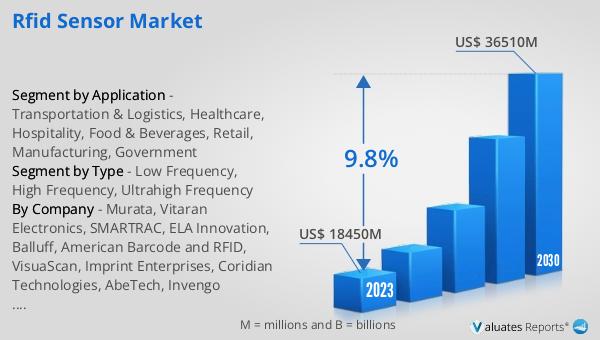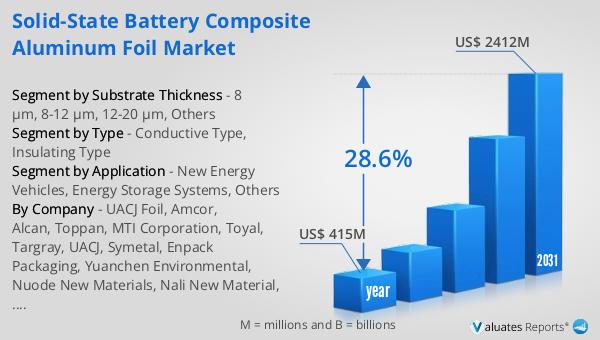What is Global RFID Sensor Market?
The Global RFID Sensor Market is a rapidly expanding sector that plays a crucial role in modern technology and logistics. Essentially, RFID (Radio-Frequency Identification) sensors use electromagnetic fields to automatically identify and track tags attached to objects. These tags contain electronically stored information which can be read from a distance, making the technology incredibly useful for a variety of applications. As of 2023, the market's value stood impressively at US$ 18,450 million, showcasing the significant investment and interest in this technology. The forecast suggests a promising future, with expectations to double its value by 2030, reaching US$ 36,510 million. This growth is attributed to a compound annual growth rate (CAGR) of 9.8% from 2024 to 2030. The expansion of the RFID Sensor Market is driven by its wide-ranging applications, from tracking inventory in retail to managing logistics in transportation, indicating its integral role in enhancing operational efficiencies across numerous industries.

Low Frequency, High Frequency, Ultrahigh Frequency in the Global RFID Sensor Market:
Diving into the specifics, the Global RFID Sensor Market is segmented by the frequency range of the RFID technology: Low Frequency (LF), High Frequency (HF), and Ultrahigh Frequency (UHF). Each frequency band has its unique characteristics and applications. LF RFID systems operate at 125-134 kHz, offering a short read range which is ideal for applications requiring less interference and close proximity reading, such as animal identification and car key fobs. HF RFID systems, operating at 13.56 MHz, provide a moderate read range and are widely used in ticketing systems, payment cards, and data transfer applications due to their ability to handle small amounts of data efficiently. UHF RFID, on the other hand, operates between 856 MHz to 960 MHz and is distinguished by its long read range, making it suitable for inventory tracking, supply chain management, and logistics. UHF RFID's ability to read multiple tags simultaneously from a distance has revolutionized inventory management and asset tracking in various sectors. The choice between LF, HF, and UHF depends on the specific requirements of the application, including range, memory, and environmental conditions, highlighting the versatility and adaptability of RFID technology in meeting diverse market needs.
Transportation & Logistics, Healthcare, Hospitality, Food & Beverages, Retail, Manufacturing, Government in the Global RFID Sensor Market:
The Global RFID Sensor Market finds its applications across a broad spectrum of industries, significantly enhancing operational efficiency and data management. In Transportation & Logistics, RFID sensors streamline the tracking of goods and vehicles, reducing manual labor and minimizing errors, thereby improving overall supply chain efficiency. The Healthcare sector benefits from RFID technology by ensuring accurate patient identification, tracking medications, and managing medical equipment, which enhances patient safety and operational efficiency. In the Hospitality industry, RFID sensors are used for access control, inventory management, and enhancing guest experiences through personalized services. The Food & Beverages sector utilizes RFID technology for tracking the production, distribution, and storage of products, ensuring food safety and compliance with regulations. Retail businesses leverage RFID for inventory management, theft prevention, and enhancing customer shopping experiences through smart fitting rooms and fast checkouts. Manufacturing industries use RFID sensors for asset tracking, automating production lines, and monitoring the conditions of goods during production. Lastly, Government applications include asset management, document tracking, and security enhancements. Across these sectors, the Global RFID Sensor Market is instrumental in driving innovation, efficiency, and security, showcasing its versatility and critical role in modern industry practices.
Global RFID Sensor Market Outlook:
The market outlook for the Global RFID Sensor Market presents a promising future, with its valuation in 2023 recorded at US$ 18,450 million. The anticipation of growth is significant, with projections estimating the market will soar to US$ 36,510 million by the year 2030. This expected growth, characterized by a compound annual growth rate (CAGR) of 9.8% during the forecast period from 2024 to 2030, underscores the increasing reliance on and the potential of RFID technology across various sectors. The doubling of the market's value within this period highlights the expanding applications and the growing demand for RFID solutions worldwide. This optimistic outlook reflects the market's capacity to innovate and adapt, meeting the evolving needs of industries ranging from retail and healthcare to logistics and manufacturing. The RFID Sensor Market's trajectory suggests a continued upward trend, driven by technological advancements and the increasing integration of RFID solutions into everyday business operations and management strategies.
| Report Metric | Details |
| Report Name | RFID Sensor Market |
| Accounted market size in 2023 | US$ 18450 million |
| Forecasted market size in 2030 | US$ 36510 million |
| CAGR | 9.8% |
| Base Year | 2023 |
| Forecasted years | 2024 - 2030 |
| Segment by Type |
|
| Segment by Application |
|
| Production by Region |
|
| Consumption by Region |
|
| By Company | Murata, Vitaran Electronics, SMARTRAC, ELA Innovation, Balluff, American Barcode and RFID, VisuaScan, Imprint Enterprises, Coridian Technologies, AbeTech, Invengo Technology |
| Forecast units | USD million in value |
| Report coverage | Revenue and volume forecast, company share, competitive landscape, growth factors and trends |
